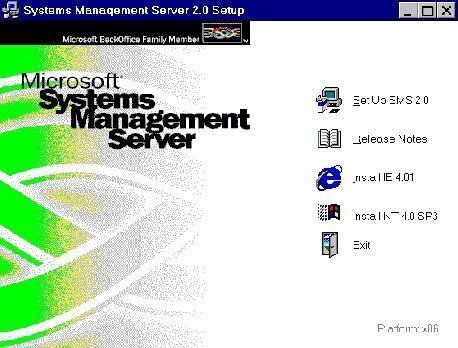Definition of Microsoft Systems Management Server (SMS) in Network Encyclopedia.
What is Microsoft Systems Management Server (SMS)?
SMS is a Microsoft BackOffice application for managing an organization’s networked computers.
Microsoft Systems Management Server (SMS) lets network administrators:
- Manage their hardware and software assets
- Distribute new software from a central location
- Manage shared applications loaded from network servers
- Perform network protocol analysis for planning and troubleshooting purposes
- Perform remote troubleshooting and remotely control individual PCs

For example, you can use SMS to determine which computers need updated drivers, which have sufficient free disk space to run new applications, how many copies of Microsoft Office are installed in your organization, and so on. This simplifies maintenance and upgrading tasks for network administrators.
Using SMS, you can also manage, install, and control server-based applications from a central location. You can perform network protocol analysis to locate and resolve bottlenecks on your network. Using the administrative tools of the Microsoft Windows NT operating system, administrators have a single, consistent administrative environment for managing their network assets.
The latest version of Microsoft SMS was: Systems Management Server 2003, released in 2003 with improved stability, reliability, and software-distribution capabilities.
How it works
SMS organizes a company’s network assets into hierarchical logical groupings of computers and domains called sites. Using the top site, an administrator can centrally manage the entire network. Sites can be designed so that sites without administrators can be managed by sites with administrators. This logical structure is scalable – as your company grows and your needs change, you can add additional sites and structure.
A typical SMS enterprise deployment might consist of the following tiers:
- A central SMS machine linked to a computer running Microsoft SQL Server that hosts the corporate inventory database, which includes centralized hardware and software inventory information on all your networked computers.
- Primary SMS servers for sharing the load of distribution to the logon servers. These are located so that the majority of network traffic generated by SMS is on local segments.
- Local area network (LAN) servers such as Windows NT and Windows 2000 domain controllers, file and print servers, and application servers.
- Clients such as Windows NT, Windows 2000, Windows 98, or Windows 95.
Software is distributed down the hierarchy, while inventory information is passed up the hierarchy. At each SMS site, inventory information is collected and forwarded to the site above it. Thus, the SMS database at the top site has complete inventory information for the entire network. From this top site, you can use the Systems Management Server Administrator program to query and view the inventory database for hardware, software, and configuration information about any computer on your network. Queries can be specific – for example, you can determine which computers in your network have Pentium processors or which systems have Office installed.
You can also use SMS to distribute and install software on clients and servers on your network, and you can schedule software distribution to minimize the impact on your system. The Systems Management Server Administrator program can
- Send software from one site to another.
- Move software to selected servers called distribution servers. Users can then access and install the software on their clients from these servers.
- Set up and configure network applications on servers for shared use by groups of users. SMS automatically creates a program item for the network application on users’ computers.
- Install and configure software on clients and servers.
The following are additional features of SMS 2 that make it easy to use:
- Integrated setup with SQL Server
- Enhanced administration using wizards, taskpads, and Microsoft Management Console (MMC)
- Context-sensitive HTML-based help
- A nonintrusive 32-bit agent client that is invisible to the user except when distribution packages are available
- A status system that provides a common reporting mechanism for all components
- Support for the Common Information Model (CIM) specification
- Dynamic, discovery-based software inventory mechanisms
- The Network Topology Tracing Tool, which provides a graphical display of the network routes between servers within a site, including infrastructure devices such as routers and hubs
- Dynamic distribution lists for sending software to users automatically when they join a group